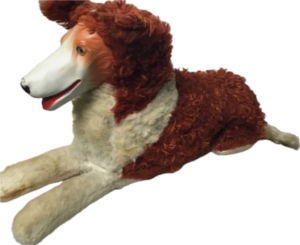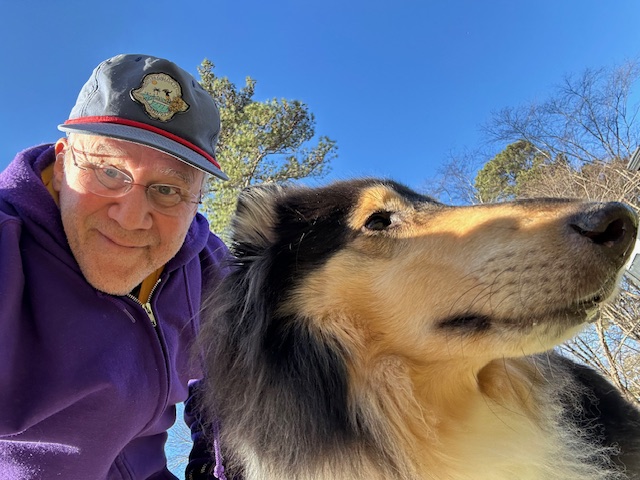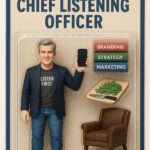Lessons from a one-eyed tri-color pure-bred collie named Walter Mitty Slater
Life has a funny way of reminding us of essential lessons when we least expect them.
As a sage marketing advisor who sells seasoned advice, I had a firm grasp of branding and consumer engagement principles. Then came my holiday assignment: caring for Walter Mitty Slater, my daughter’s one-eyed tri-colored pure breed collie.
This unexpected mentorship from a canine companion reminded me of some fundamental marketing truths that we sometimes overlook or easily forget.
Let me be clear: I’m not typically a “dog person.” I speak meow.
My expertise lies in marketing and brand strategy, not in distinguishing between different types of kibble or navigating poop patrol.
However, my week with Walter gave me pause – sorry, to think about my brand and marketing advice.
The Power of Distinctive Assets
Walter’s most noticeable feature is that he has one eye, which he lost years ago to an illness. While this might seem a disadvantage, it’s become his signature characteristic. People remember him. They ask about him. They connect with his story. There is a crucial marketing principle called the distinctive brand asset—those unique elements that make a brand instantly recognizable and memorable. It is a symbol that can only remind someone of your brand.
Coca-Cola – The distinctive red color and the curved “Cola” script lettering
McDonald’s – The golden arches symbol and the bright red/yellow color combination
Nike – The “Swoosh” logo and “Just Do It” tagline
Apple – The bitten apple logo and minimalist white/silver aesthetic
Cadbury – The distinctive purple color (Pantone 2685C) used across their packaging
Shell – The red and yellow shell symbol
Intel – The distinctive “Intel Inside” sound signature/chime

Mastercard – The overlapping red and orange circles
Absolut Vodka – The distinctive bottle shape based on old Swedish medicine bottles

Campbell’s Soup – The red and white can design and distinctive cursive font
In a recent project, we used a little boy with BBQ sauce all over his face as a distinctive asset to create Lid Licking Sauce.
Walter’s distinctive feature doesn’t diminish his appeal; it enhances it, making him unforgettable in a sea of four-legged friends at the dog park.
Brands need a distinctive asset that shows up in all of their marketing efforts.
Authentic Storytelling Creates Connections
Taking care of Walter also triggers a personal memory about my childhood stuffed animal, Lassie. Neighbors would ask, is he your dog?
These interactions taught me something profound about storytelling in marketing: the most powerful stories aren’t always about the product itself but the connections it enables.
When brands share authentic stories, they create similar opportunities for connection. Think about Patagonia’s environmental activism stories or Airbnb’s host narratives. These aren’t just marketing materials; they’re bridges that connect human experiences, just like Walter’s story connects me to curious strangers on our daily walks.
My mother always had a spare Lassie stuffed animal in case I lost him. When our older daughter Sarah was younger, we kept a spare Bert (or was it Ernie) doll around just in case, too.

Brands need a story that is memorable and meaningful to your audience.
Consistency Builds Trust
Collies thrive on routine, and Walter ensured I never forgot it. Exact walking times, same feeding schedule, same play routine.
Any deviation was met with those piercing eyes (well, eye) that seemed to say, “This isn’t how we do things.”
Walter’s routine reminded me of the importance of brand consistency.
Just as Walter expects his walks at specific times, consumers expect consistent experiences from brands they trust. Whether it’s Nike’s commitment to athletic excellence or Volvo’s unwavering focus on safety, successful brands maintain consistency in their messaging, values, and customer experience. Deviation from these established patterns can create discomfort and erode trust. Even social media posts at the same time of day can help build a relationship and expectation.
Brands need consistency to help gain attention and break through the clutter.
Adapt to Your Audience
Despite my initial “not a dog person” stance, I quickly learned to read Walter’s signals and adjust my behavior accordingly. He communicates differently when he wants to play than when he needs to go outside, and understanding these cues was crucial for our successful interaction. I now know the difference in his growl from “let’s go outside” to “let’s play inside.”
This adaptability is crucial in marketing, too.
Different audience segments communicate and consume content differently. The key to successful engagement isn’t just broadcasting your message but understanding how your audience prefers to receive and interact with information.
Walter also has a mind of his own, and although I can try to lead him in one direction, sometimes I have to follow his lead. This is not unlike how great brands need to observe and listen more than they try to lead customers down a specific path.
Your job as a brand or marketing leader is to understand your audience. Study them, observe them, and don’t assume you know them. Are they hungry, do they want to play, or is it time for a chance to mark the mailboxes and fertilize the neighbor’s lawn?
The Value of Genuine Engagement
One of the most surprising aspects of dog-sitting was how many meaningful conversations emerged from our walks. Walter’s presence created natural opportunities for engagement with neighbors and other dog owners. These weren’t forced interactions but organic conversations that developed naturally.
This mirrors the most successful social media and community engagement strategies. The best brand interactions don’t feel like marketing; they are natural conversations. They arise from shared interests, genuine curiosity, and authentic connection points.
Walter is like social media, constantly engaging and attracting attention. And a few treats, too.
Innovation Within Boundaries
Collies are known for their intelligence and need for mental stimulation. I had to get creative with Walter within our environment and schedule constraints.
This parallel extends perfectly to marketing: the best innovations often come from working within established constraints rather than trying to reinvent everything from scratch. I call this marketing within the box – the box is the various constraints that are helpful to a brand.
When I realized how easily Walter would eat my turkey sausage off my plate, I figured out how to give him the daily pill he needs. Who needs Dog GBT?
Unleashed Joy
My week with Walter reminded me that marketing fundamentals are everywhere if we want to see them. In our rush to embrace new technologies and techniques, we sometimes forget that the core principles of human connection, consistency, and authentic engagement remain unchanged.
Just as Walter’s distinctive one-eyed appearance became an asset rather than a liability, our brands’ unique characteristics – even those that might initially seem like challenges – can become our greatest strengths when embraced authentically and consistently.
I carry these refreshed marketing insights as I return to my routine, minus the scheduled walks and tennis ball throwing.
Sometimes, the best professional development doesn’t come from conferences or workshops but from unexpected mentors – even if they are furry and fond of squeaky toys.
You just have to keep your eye open.
Connect with Jeff at The Marketing Sage Consultancy. Interested in setting up a call with me? Use my calendly to schedule a time to talk. The call is free, and we can discuss your brand and marketing needs.
If you want to learn more about my new offering, The Trusted Advisor Board, you can click here to learn the details. Feel free to email me at jeffslater@themarketing sage.com or text 919 720 0995. Thanks for your interest in working with The Marketing Sage Consultancy.





